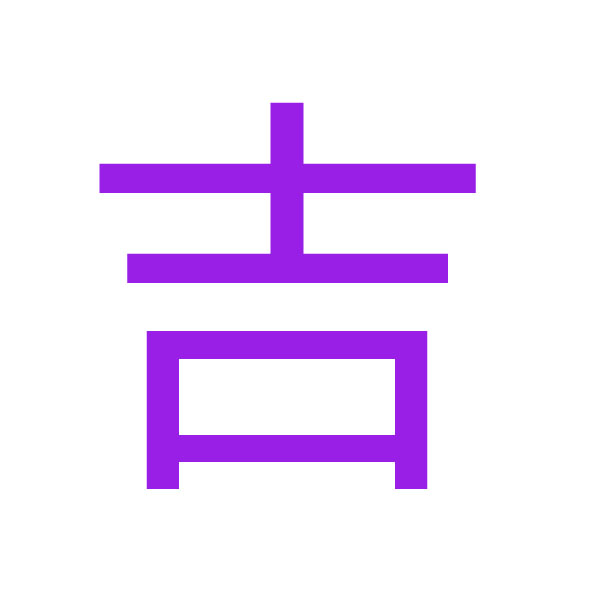
1. Kanji Breakdown: 吉
This kanji is one of the most auspicious and positive characters in Japanese, representing good fortune.
Meaning: Good luck, auspiciousness, fortune.
Reading:
Onyomi (Sino-Japanese reading): キチ (kichi), キツ (kitsu)
Kunyomi (Native Japanese reading): よし (yoshi)
The kanji is a compound ideograph (会意文字). It consists of two parts:
Top (士): This means "samurai" or "gentleman," representing a person of virtue and good standing.
Bottom (口): This means "mouth," representing words, speech, or an opening.
The traditional interpretation is that it represents "auspicious words from a virtuous person." When a respected person speaks positive words, it brings good fortune. Another interpretation is a "fortune-teller's (士) mouth (口)" giving a positive prophecy.
2. Stroke Order and Writing
Learning the correct stroke order is crucial for balanced and beautiful kanji. "吉" has 6 strokes.
Here is the stroke order diagram and explanation:
Total Strokes: 6
Start with the top horizontal stroke. (From left to right)
The vertical stroke. (From top to bottom)
The bottom horizontal stroke of the "士" radical. (The longest horizontal stroke)
The left vertical stroke of the "口" radical. (From top to bottom)
The top and right vertical stroke of the "口" radical. (This is one continuous stroke that turns)
The final horizontal stroke that seals the bottom.
Key Writing Tips:
Write from top to bottom.
The top part "士" should be slightly narrower than the bottom part "口".
The final horizontal stroke (stroke 6) is crucial for providing a stable, "grounded" feel to the character.
The overall character should feel solid and well-balanced, reflecting its positive meaning.
3. Vocabulary and Example Sentences
Here are some common words and names using "吉" and how to use them in sentences.
Vocabulary
吉 (きち, kichi / よし, yoshi)
Meaning: Good luck, good omen.
Example: 今日は吉の日だ。
Romaji: Kyō wa kichi no hi da.
English: Today is an auspicious day.
吉日 (きちじつ, kichijitsu)
Meaning: Lucky day, auspicious day (often used for choosing dates for weddings, opening businesses, etc.).
Example: 結婚式の日取りを吉日に選んだ。
Romaji: Kekkonshiki no hidori o kichijitsu ni eranda.
English: We chose a lucky day for the wedding date.
吉報 (きっぽう, kippou)
Meaning: Good news, glad tidings.
Example: 無事の知らせという吉報が届いた。
Romaji: Buji no shirase to iu kippou ga todoita.
English: Glad tidings arrived that they are safe.
大吉 (だいきち, daikichi)
Meaning: The best possible fortune, great good luck (the best omen when drawing a fortune slip at a shrine).
Example: おみくじで大吉を引いた!
Romaji: Omikuji de daikichi o hiita!
English: I drew "excellent luck" on the fortune slip!
吉田 (よしだ, Yoshida)
Meaning: A very common Japanese surname.
Example: 吉田さんは私の先生です。
Romaji: Yoshida-san wa watashi no sensei desu.
English: Mr. Yoshida is my teacher.
Summary
Kanji: 吉
Core Meaning: Good Luck, Auspiciousness, Fortune.
Readings: On'yomi キチ (kichi), Kun'yomi よし (yoshi)
Stroke Order: 6 strokes. Remember it's composed of 士 (samurai/virtue) and 口 (mouth/words). Practice writing it step-by-step to master its fortunate form.
This kanji is central to expressions of good fortune and is very common in names. By mastering its stroke order and vocabulary, you will be able to correctly write and use this very positive character.